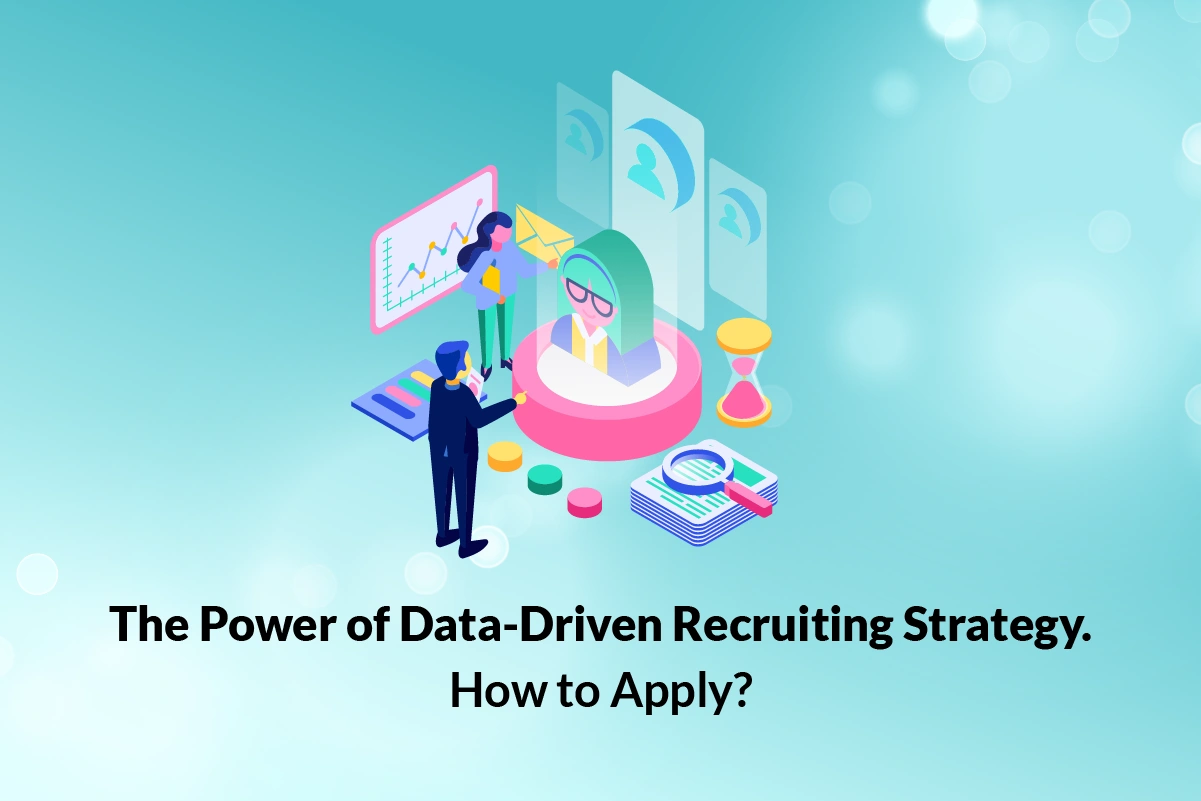Recruiting for jobs has traditionally been an instinctive and emotional process, with interviews and resume screening being the only options. But many employers are adopting a new approach called data-driven recruiting strategy.
This approach allows recruiters and HR teams to use data to see how their hiring process is performing and where they need to improve. It is expected to cut down on the number of interviews, time spent vetting, time to hire, as well as other recruiting costs.

What Is Data-Driven Recruiting?
Data-driven recruiting refers to employers making hiring decisions based on data instead of solely on interviews, resume screening, and other methods that don’t scale. As a result, hiring decisions should occur faster and become more objective.
Recruiters now rely on a range of hiring metrics to monitor the success of their hiring process, leveraging insights to effectively improve their hiring process.
In addition to saving you time and money, these metrics could help you reach your Diversity and Inclusion goals quicker as the data driven approach can help eliminate biases.
Technology advancements have played an essential role in the growing popularity of the data-driven recruiting strategy. Many companies and businesses have software that can do some of the work for them, often called applicant tracking systems.
Benefits of Data-Driven Recruitment
There are plenty of good reasons to incorporate a data-driven recruiting strategy into your hiring process.
Shorten the Hiring Process
Through data collection, recruiters will know where the bottlenecks in their recruitment process are. As a result, they can find ways to automate or eliminate them.
We recommend mapping out your hiring process by gathering details such as:
- Candidate dropout rate.
- Average time to hire for each position.
- Average number of submissions and interviews.
- Time in each stage of the recruitment steps.
These insights give you a more accurate estimate of your hiring process from beginning to end. Moreover, your recruiters become confident in communicating with stakeholders realistic timeframes.
Reduce Hiring Costs
Adopting a data-driven recruiting strategy also allows you to reduce recruitment costs.
Your recruiting team’s time is money. As they become more efficient in filling roles, one person can handle more open roles than they could before they had data tools.
Make More Objective Decisions
Thanks to data-driven recruiting, your recruitment process will be more objective, allowing you to receive the right talent for your positions. Many studies show that diverse teams can lead to higher profits. New ideas and innovation comes from having people that think differently at the decision table.
In addition, your brand’s reputation is at stake. You want to be sure that your team is treating all candidates fairly, regardless of ethnicity, gender, age, or race, that all are mentioned in the EEO statement. Your company will have a diverse workforce that will improve business performance and foster creativity and innovation.
Improve Candidate Experience
Let’s say you are a candidate who applies online to countless companies. Eventually, you’ll constantly receive job announcements, company updates and engagement emails from these companies.
If one of the companies you applied to had a tedious and lengthy hiring process, you might want to kiss their interview invitation goodbye. Candidates can now easily compare how you treat them to how other companies perform.
A smooth, fair, and faster hiring process is what candidates expect and what data helps you provide. That’s why companies are embracing the latest technologies in their hiring process.
Setting up Your Recruiting Team for Success
With the right data-driven recruiting strategy, your recruiting team can expect to build an iterative process that facilitates the right hiring decisions.
Hiring managers and recruiters will be more confident with the selection process as they have data to prove that they made the right choice. In addition you can more easily set goals for them to achieve and tie incentives to.
Being Proactive Instead of Reactive
Using data allows you, as a leader, to predict recruitment needs and create a reasonable recruitment plan that fits the budget. That way, you can proactively prepare for what’s to come instead of reacting passively to the situation and losing productivity as you scramble to fill a seat.
Metrics for Data-Driven Recruiting
You can choose from many metrics, depending on your company’s capabilities and how much you want to pay for data tracking.
The metrics your company chooses to track will vary depending on what your company feels is most important. Here are some metrics your company can choose to track:
- Cost per hire
- Source of hire
- Job offer rate
- New hire performance
- Careers page conversion rate
- Qualified applicants per hire
- Application conversion rate
- Time to hire
- Candidate feedback
- Percentage of bad hires
- Resignations and another turnover rate
- New hire time to productivity
- Referral source per candidate

Data-Driven Recruiting Strategy for Hiring Success
Step 1: Pick Relevant Metrics and Determinate Data Sources
As mentioned above, there are various forms of data your business can use for the hiring process.
Review your company’s mission, values and goals to start narrowing this list down. Then identify the metrics that will show you that your recruiting process is driving you to these goals..
Step 2: Develop a recruitment dashboard
If your team can’t see the metrics, they won’t know how they are performing. Creating a recruiting dashboard will allow you to visualize data, identify issues, and spot trends quickly.
In most cases, it will show applicant, hire, budget, and campaign data. Individuals should be able to review this daily and discuss as a team the positive and negative trends, weekly.
Step 3. Determine Necessary Actions
The data-driven recruiting strategy doesn’t just mean tracking data. It also requires you to act on it.
For instance, if you notice that your company has recently received many lower-quality applicants, you’ll need to check where they’re coming from to stop advertising your job there. If you notice time to hire is growing, you’ll need to communicate the trend change to stakeholders as you identify why it’s happening.
Step 4: Think About Data Limitations
Data can’t tell everything about a candidate. So when using any data, don’t assume it will tell the whole story. When you spot a trend, Instead, dig deeper into the situation by talking to the team. Data supported by human intuition and observation is the most powerful.
Step 5: Comparing Data Over Time
The data will come in handy in comparing the state before you make any changes and the state after.
That way, you can see if your recruitment process is producing your expected results. You can then make the necessary adjustments to improve the recruitment process.
Take Away
We’ve walked you through important information about the data-driven recruiting strategy and how it can be a helpful tool in your recruitment process. Hopefully, the above information is helpful to you!
Thanks for your time!
References
- Linkedin. (2015). Data Driven Recruiting. California: Linkedin. Retrieved from https://business.linkedin.com/content/dam/business/talent-solutions/global/en_us/c/pdfs/linkedin-ddr-ebook-final.pdf
- Linkedin. (2017). Top 10 metrics for the data-driven recruiter. California: Linkedin. Retrieved from https://www.hrportal.co.il/wp-content/uploads/2018/05/what-recruiters-should-measure-10.2-rc-05.pdf


